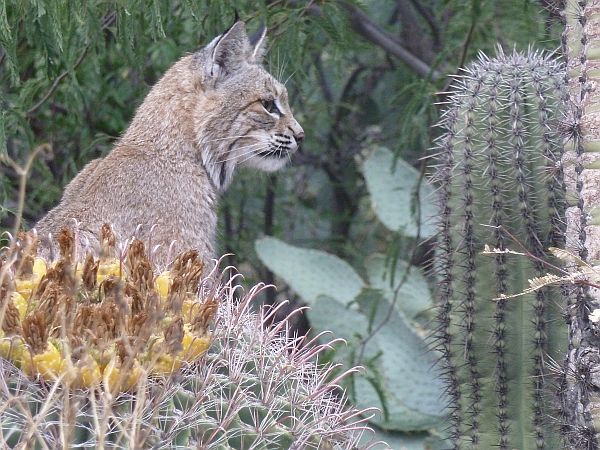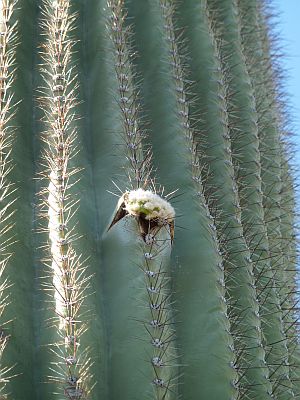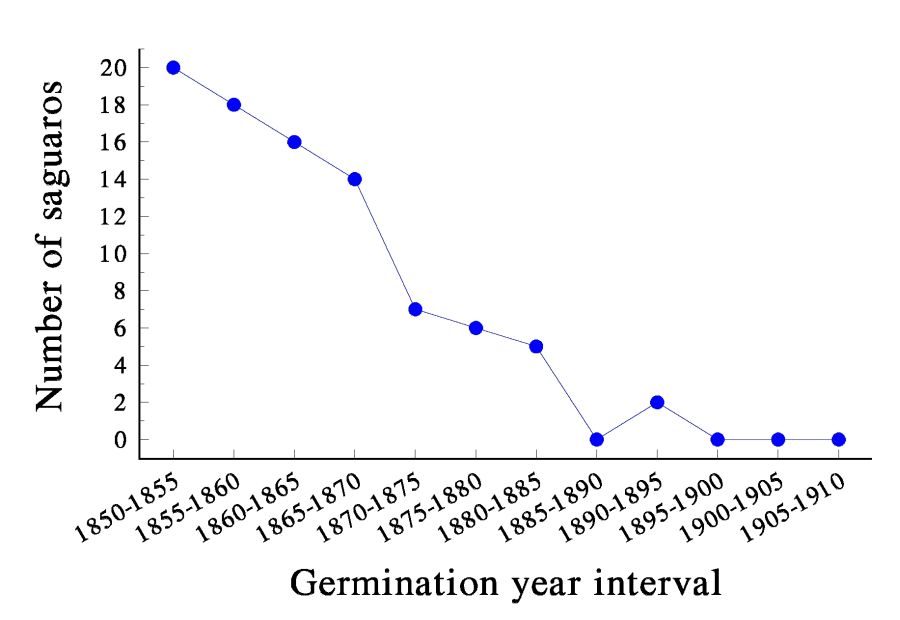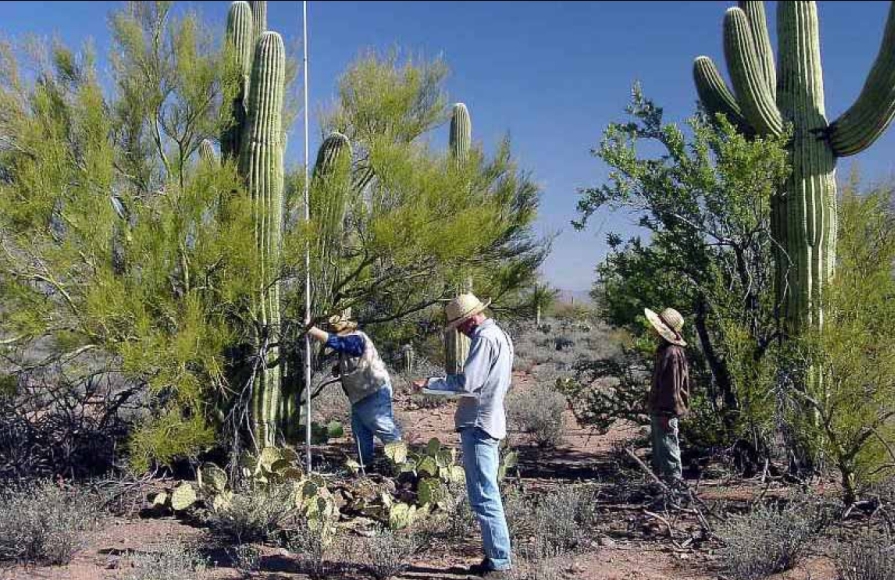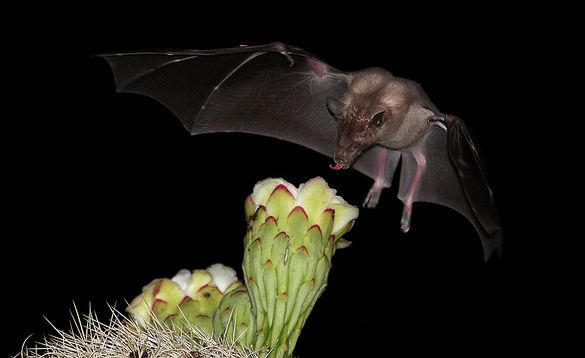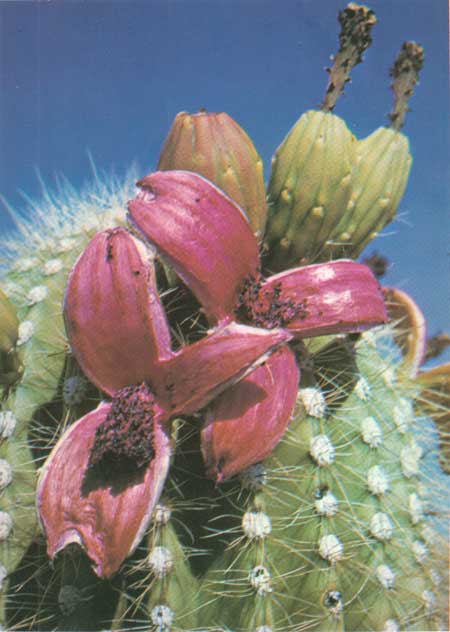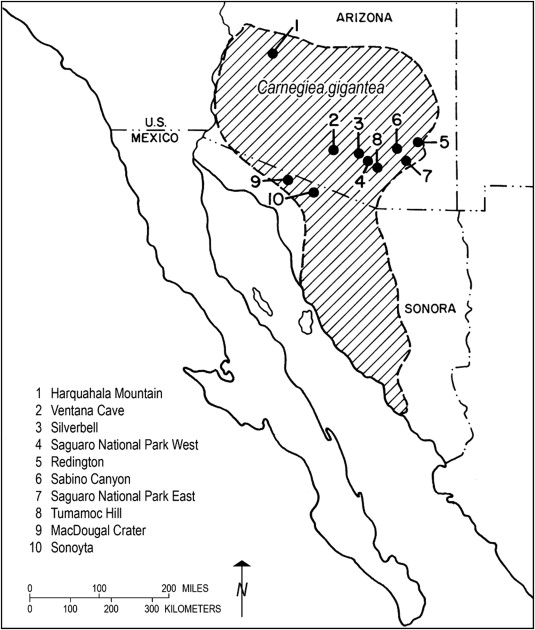Then, in 1964, J. R. Hastings & Ray Turner revived the study by setting out four large subplots. These plots are still monitored. After 85 years, they gave us a real look at what is going on (Pierson & Turner. 1998. An 85-year study of saguaro (Carnegiea gigantea) demography. Ecology 79:2676-2693). It is remarkable.
|
Times of saguaro recruitment are clustered together in episodes. On the order of once or twice a century, a local population has a boom period. Their land overflows with young saguaros, all about the same age. This is called a cohort. But in between these episodes, saguaros experience extended periods of failure. |
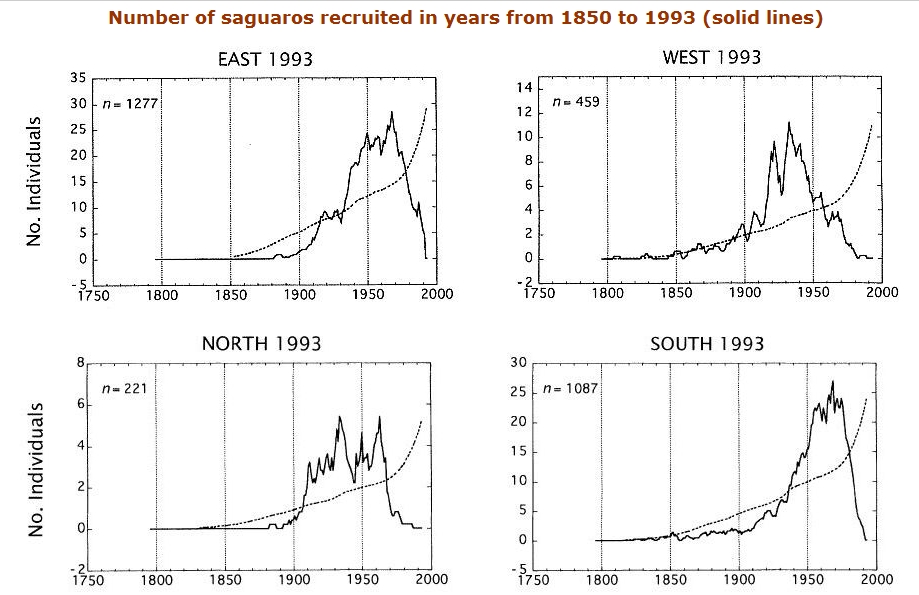 |
The figure above shows saguaro recruitment in the four Tumamoc Hill subplots from 1850 to 1993. There is a sharp peak in recruitment in the East Plot from 1940 through 1970; there is one in the West Plot from 1920 through 1960; there is one in the North Plot from 1910 through 1970; and there is one in the South Plot from 1940 through 1970. |
After germinating, the members of the cohort grow; they flower; they even set their seeds. But it largely comes to naught. The cohort dwindles as more and more individuals die without replacement. It looks like curtains for them. And then the magic happens again. We are not sure why. We do know that the answer is not rainfall. Good rains come at far more than 75 or 100 year intervals! But not good saguaro recruitment years. Over a century and we have not done enough research! |
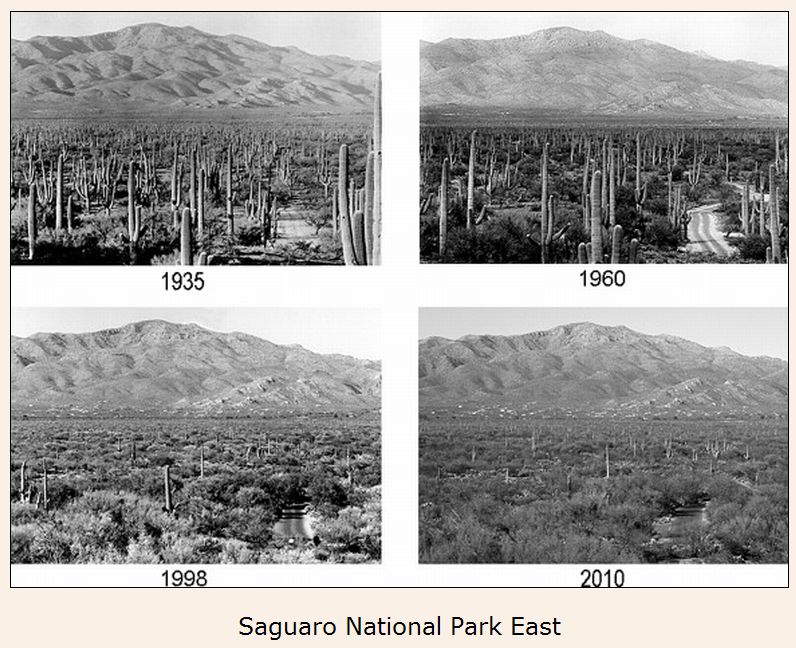 |
The same pattern shows up in the land set aside for Saguaro National Park, but the times are different. Look above at the repeat photographs taken in the eastern part of the park, the part that Homer Shantz selected in 1928 because of its abundant supply of vigorous saguaros. From 1935 to 2010, saguaros dwindled almost to the vanishing point. Meanwhile the Tumamoc population was burgeoning. It does seem fitting that such a majestic creature should be characterized by a stately rhythm of reproduction. |
|
Besides frost, other quite significant sources of adult saguaro mortality are lightning (Steenbergh, 1972. Lightning-caused destruction in a desert plant community. Southwestern Naturalist. 16:419-429) and windthrow. |
You can easily tell when lightning has killed a saguaro. The main body of the cactus is fried to its skeleton but its green arms simply fall off and remain green for a long while before they die. (They do not take root however.) Look for examples on the Hill. |
Windthrow of a saguaro happens when a good soaking rain is followed by unusually high winds. The soft, water-soaked soil simply cannot hold the tall, heavy, shallow rooted cactus. Down it goes. |
|
NEWER RESEARCH PROJECTS
|
Saguaro Spines as Records of Past Climate
|
If you are very clever working with isotopes, you can tell past climate conditions by testing saguaro spines. They take carbon from the atmosphere and grow out of the tip of a saguaro stem or arm. Most of their carbon is ordinary carbon-12, but some is the rare, radioactive carbon-14 isotope. Only one carbon-14 atom exists for every 1,000,000,000,000 carbon-12 atoms. Carbon-14 is the isotope that has given us the ability to date material in such disparate fields as archaeology and palaeoclimatology. |
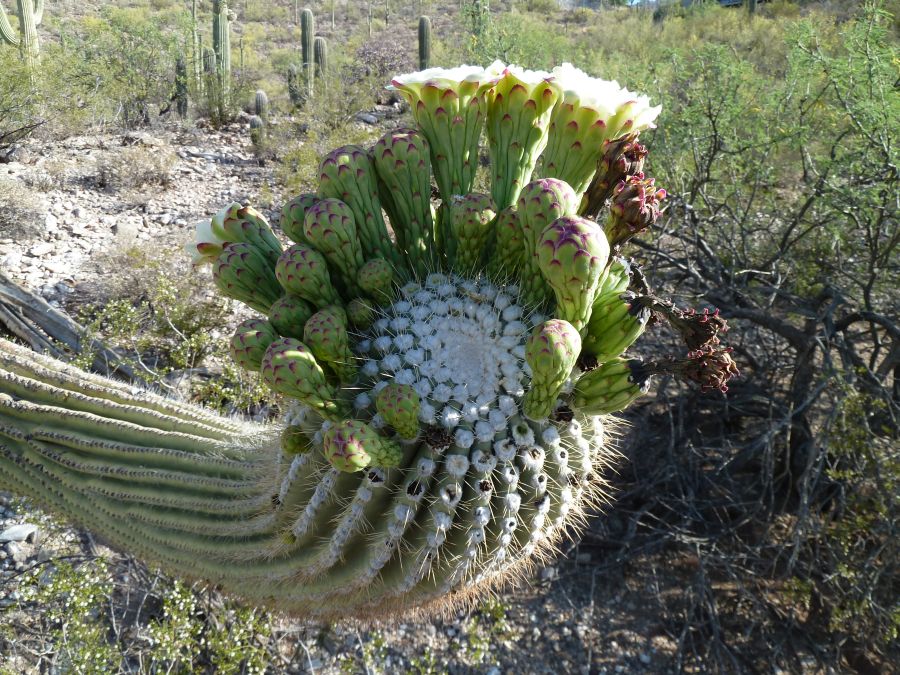
Actively growing tip of a saguaro. Photo by David Dettman.
Velvety white circular shapes are new areoles with their developing spines. |
The growth cells forming new spines die in a few days. But they keep the carbon they used while building the spine. The spine, itself, containing those cells, lasts for many decades. |
The carbon isotopes available for spine growth vary regularly during the year and between years, too. When growing conditions are relatively good, a smaller proportion of the new tissue of a spine is the carbon-14 isotope. Meanwhile, as the stem lengthens year after year, the spine holds its postion and new spines grow at the tip. Thus the farther away a spine is from the tip, the older it is. And by looking at the proportion of carbon-14 in the parade of spines along a saguaro rib from bottom to top, we get a sequential record of growing conditions encountered by the cactus during its lifetime (English, Dettman, Sandquist & Williams. 2007. Past climate changes and ecophysiological responses recorded in the isotope ratios of saguaro cactus spines. Oecologia 154:247-258. DOI 10.1007/s00442-007-0832-x). |
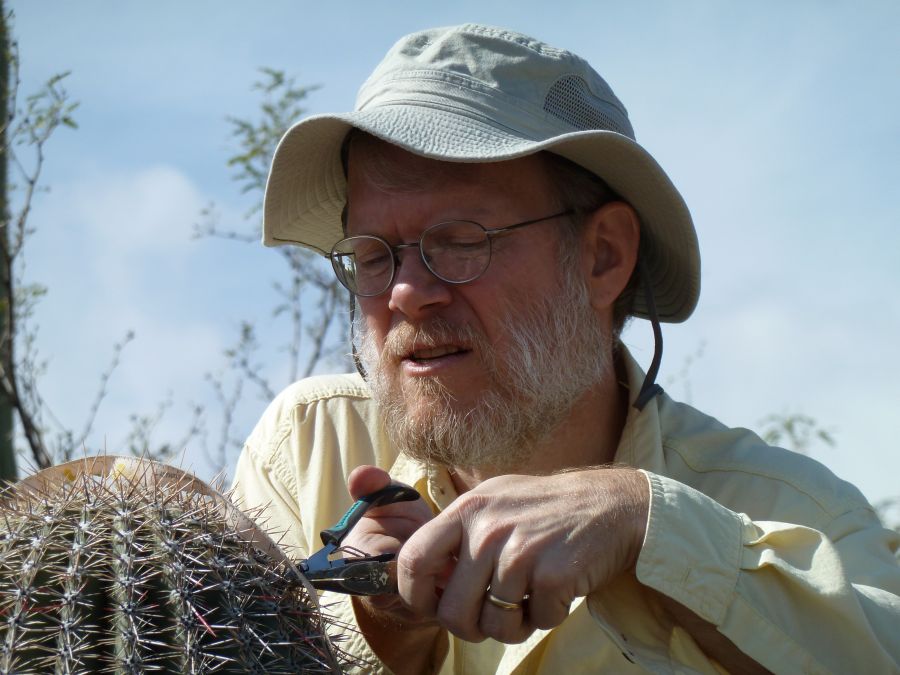
Williams carefully harvests spines for isotope analysis. Photo by David Dettman.
|
It's a breakthrough. As big as they are, giant cacti have no growth rings, and the desert lacks the trees that could reveal past desert climate. But now, although they have no growth rings, saguaros will be able to do the job. |
The Saguaro Genome
|
Plants, just like animals, have genes and genomes. Only in recent years have we had the technology to read those genomes. |
As befits the world's oldest desert research lab, one of its veterans, a century-old Tumamoc saguaro that grows along one of the paths near the old laboratory building, was the very first cactus to have its genome deciphered. It was biopsied in 2013.
|
|
PROSPECTS |
We don't know what other secrets are waiting for our persistent efforts to uncover them. Tumamoc and its saguaro story are an object lesson in the importance of long term research. Very long term research. The Spaldings would be proud to know it. So would Forrest Shreve. |
So Tumamoc keeps up its saguaro research. The plots that Hastings and Turner trimmed out of the old Spalding effort were very recently restudied by Ray Turner, Bob Webb and Susana Rodriguez. They used modern methods of global positioning and digitization, which improve our ability to analyze and compare individual plants and different years. |
Tumamoc is the National Historic Landmark that is still making history. |
|
